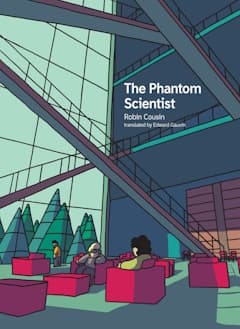
The Phantom Scientist by Robin Cousin, translated by Edward Gauvin
(The MIT Press, 2023)
Reviewed by Steven French
Strikingly illustrated and thoughtfully written, this is a story about an isolated but lavishly funded institute for the study of complex and dynamic systems. It begins with the new Director, Sorokin, greeted at the gates by a balaclava wearing security agent with a rifle strapped across their back. As it turns out, this is the fourth iteration of the institute and as the previous Director explains via video, like the dynamic systems under study, it too tends towards chaos and increasing entropy. That’s why a new resident is selected every three months in order to ‘rebalance’ the system, each one a researcher in some field covered by systems theory, until all twenty-four labs are occupied. By that point their research is expected to yield results, despite the inevitable spread of disorder.
After this introduction, the story advances six years with the chaos spiking too early and Sorokin hoping that the latest and final resident will calm things down. This is Stéphane Douasy, a happy-go-lucky physicist working on morphogenesis who, as the acknowledgments indicate, is based on real-life physicist Stéphane Douady, well-known for his work on the mathematics of plant growth. Stéphane soon meets two of the other residents—Vilhelm, who is designing a computer program that will predict his own actions and Louise, a linguist looking into recurrent forms in sentence structures. Sadly, and foreshadowing the current furore over ChatBot, her research has been pre-empted by Google’s launch of their ‘Cleverbot’ app. This leaves her plenty of time to investigate the case of ‘The Phantom Scientist’—her name for the fourth resident of their building who they’ve never seen or heard. This turns out to be Vinaiy Paniandy who is working on the ‘P vs. NP’ problem which, put simply, has to do with the issue of whether every decidable problem whose solution can be easily verified (NP) can also be easily solved (P). Widely regarded as the most important open problem in computer science, this has major implications for A.I., cryptography, mathematics and a range of other disciplines. As Vilhelm explains to Louise, some NP problems combine the difficulties of all the others and are called ‘NP-complete’. If an algorithm could then be found to solve one NP-complete problem, it would work for all the rest and that would show that NP problems are also P problems. Such an algorithm could then solve any problem with a valid solution and could, as Vilhelm helpfully points out, prove theories, discover new theorems and, generally, ‘get creative’.
Although Paniandy originally argued that this was not possible, Louise comes to believe that he had in fact proved P=NP, working from a map of the Institute itself as an example of the NP-complete ‘travelling salesperson’ problem (that of finding an algorithm that will tell you what is the shortest path connecting a series of points in space). The problem now, she realises, is that of the whereabouts of Paniandy himself but then the chaos intrudes with a localised robot uprising and the deaths of two of the Institute’s residents. With only 36 hours to solve the puzzle before the armed and balaclavaed ‘clean-up crew’ arrive, things spiral out of control and beyond the confines of the Institute, yielding a dramatic and unpredictable finale. A sense of calm and order is then restored in a kind of epilogue, with a slide of Douasy’s lecture on ‘Folds and Forms of Leaves’ as the book’s final images.
This is a beautiful and sublime piece of work. The graphics are simple and the colours bold, standing in contrast with the complexity of the ideas touched on in the story which, ultimately, have to do with how science works and the nature of creativity itself.
Review from BSFA Review 21 - Download your copy here.
